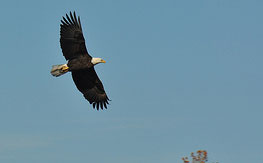Embedding Direct Quotations

Source: Haliaeetus leucocephalus, Jörg Hempel, Wikimedia Commons
A direct quotation supports your argument or explanation. Your readers should not have any questions about how a particular quotation is relevant. It is your responsibility, not theirs, to clearly connect the quotation to your claim. You should never drop a quotation into your writing and let it stand alone, unloved, and seemingly disconnected from the information around it. Consider the lonesome quotation in these two sentences:
Although the bald eagle is still listed as an endangered species, its ever-increasing population is very encouraging. “The bald eagle seems to have stabilized its population, at the very least, almost everywhere.”

Source: Bald Eagle, kansasphoto, Flickr
The reader is left to make connections and figure out why the words are so important that they’re directly quoted. Additionally, even though both sentences are about bald eagles, they don’t flow together well stylistically.
Notice how much more meaningful, smooth, and logical the information is when the quotation is introduced and then embedded into this sentence:
Although the bald eagle is still listed as an endangered species, its ever-increasing population is very encouraging. According to ornithologist Jay Sheppard, “The bald eagle seems to have stabilized its population, at the very least, almost everywhere.”
Ah, that’s much better.
Speaking of better, I mentioned in the introduction that there are three types of direct quotations: acceptable, better, and best. Below is an explanation of each type. The list begins with a dropped quotation—unacceptable—and shows how each successive category of quotation improves on the previous one.

Source: Normandy Invasion June 1944, Wikimedia Commons
- Unacceptable embedding (dropped quotation): “The battle was lost before it began.” (Yikes! Who said it and in what context?)
- Acceptable embedding: The general said, “The battle was lost before it began.” (Oh, the general said it. But that’s very simple sentence construction, and what’s the context?)
- Better embedding: “The battle was lost before it began,” admitted the general. (The sentence structure and verb are certainly more interesting, but can’t the quotation or, at least the most important part of it, be smoothly embedded into a more sophisticated sentence?)
- Best embedding: General Arnold acknowledged defeat and admitted that the fight “was lost before it began.” (The sentence structure is good, and details have been added, but more importantly, the quotation is seamlessly embedded in the sentence. Someone listening to it would not know that a quotation was included.)
The bottom line is, embedding direct quotations makes writing more readable and sophisticated.
Basic guidelines for embedding quotations
Make it clear to the reader which information comes from you and which comes from a source. A signal phrase is a phrase, clause, or full sentence that introduces borrowed material. Signal phrases cue the reader that the material comes from an outside reference. Varying your signal phrases keeps your writing from becoming monotonous: “according to Jane Doe,” “as Ms. Doe goes on to explain,” “as one critic points out,” “John Doe emphasizes,” “Doe insisted that,” “in the words of the president,” “John Doe observed that,” etc. Keep in mind that your word choice connects the source to your argument.
Signal phrases often incorporate verbs or verb phrases. The verb needs to fit the situation. Does the source claim, argue, observe, conclude, refute, or state? A list of verbs—a purposely long list—follows to help you think about possibilities for your own writing.
|
Acknowledges |
Delineates |
Posits |
|
Adds |
Denies |
Presents |
|
Admits |
Discloses |
Proposes |
|
Advances |
Discounts |
Purports |
|
Affirms |
Disputes |
Reasons |
|
Agrees |
Documents |
Recounts |
|
Alludes |
Emphasizes |
Refers |
|
Argues |
Explains |
Reflects |
|
Asserts |
Expresses |
Refutes |
|
Attests |
Extrapolates |
Reiterates |
|
Characterizes |
Grants |
Relates |
|
Chronicles |
Highlights |
Remarks |
|
Claims |
Hypothesizes |
Replies |
|
Comments |
Illustrates |
Reports |
|
Compares |
Implies |
Responds |
|
Concludes |
Indicates |
Reveals |
|
Concurs |
Insists |
States |
|
Confirms |
Maintains |
Submits |
|
Contends |
Narrates |
Suggests |
|
Contrasts |
Negates |
Supports |
|
Creates |
Notes |
Theorizes |
|
Declares |
Observes |
Verifies |
|
Defines |
Points out |
Writes |
Signal Phrases List from Saint Joseph College in Connecticut
When you embed quoted material into your own sentences, be sure that the combination of your words with those from an outside source makes grammatical sense. Be sure that your verbs agree with their subjects, that pronouns agree with their antecedents, and that you maintain parallelism across your citation. You have been effective if someone listening to the sentence cannot tell where your words end and where the quotation begins. To ensure seamless reading, you may have to use ellipses (. . .) or brackets [ ].
The sentences below from Frankenstein by Mary Shelley show the most common uses of these punctuation marks. Consult the MLA Handbook for more examples.
Omitted text in the middle of a sentence
“At that age I became acquainted with the celebrated poets of our own country; but it was only when it had ceased to be in my power . . . that I perceived the necessity of becoming acquainted with more languages than that of my native country.”
Omitted text at the end of a sentence
“At that age I became acquainted with the celebrated poets of our own country; but it was only when it had ceased to be in my power to derive its most important benefits from such a conviction that I perceived the necessity of becoming acquainted with more languages. . . .”
Text added inside a quotation to clarify or explain
“At that age [of 15] I became acquainted with the celebrated poets of our own country; but it was only when it had ceased to be in my power to derive its most important benefits from such a conviction that I perceived the necessity of becoming acquainted with more languages than that of my native country.”
Note: Also use four ellipses if an entire sentence is omitted from the middle of a paragraph.
Block quotations
If a direct quotation is more than four lines long within the text of your paper, it should be set off as a block quotation. A block quotation should be formatted like this:
In the book Zen and the Art of Motorcycle Maintenance: An Inquiry into Values, the narrator reflects on motorcycle maintenance and Sylvia and John’s attitude about it:
Inability on their part is ruled out immediately. They are both plenty bright enough. Either one of them could learn to tune a motorcycle in an hour and a half if they put their minds and energy to it, and the saving in money and worry and delay would repay them over and over again for their effort. And they know that. Or I don’t know.
I never confront them with the question. It’s better to just get along. (12)
This passage makes several things clear. For one, the narrator is frustrated by traveling with his friends . . .
Indent from the left margin one inch (two tabs). Double-space within, before, and after the quotation. Even though you’re using the writer’s exact words, do not enclose a block quotation in quotation marks. (Use quotation marks within the block quotation, however, if the passage you’re quoting contains them.)
Use the following sentences to practice embedding quotations. Try different ways of combining each group of sentences into one sentence that contains a properly embedded quotation. Rewrite the sentences using your notes. When you’re finished, check your understanding to see some suggested combinations. Remember that since there are several ways to embed quotations, your sentence may be correct even if it’s different from the suggested response. Pay special attention, however, to the punctuation in your sentence and in the suggested one.
- Mr. Loftis was working in his fields yesterday. He saw something unusual. “The flying saucer appeared right before my own two eyes.”
- Gretchen realizes something. She regrets that she screamed at her boyfriend, Ross. “I should think before I speak.”
- “They don’t belong anywhere.” Jorge said this. He thinks that carnival workers have no real homes.
- Teresa is talking to Lucy very quietly. “You close the window, and I’ll lock the door.”
Sample Responses:
- Mr. Loftis reported that when he was working in his fields yesterday, a “flying saucer appeared right before [his] own two eyes.”
- Now that Gretchen realizes she “should think before [she] speak[s],” she regrets that she screamed at her boyfriend.
- Jorge remarked that carnival workers have no real homes: “They don’t belong anywhere.”
- “You close the window,” Teresa whispers to Lucy, “and I’ll lock the door.”